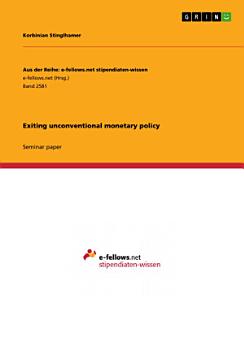Exiting unconventional monetary policy
2017年10月 · Aus der Reihe: e-fellows.net stipendiaten-wissen 第 2581 本图书 · GRIN Verlag
电子书
19
页
family_home
符合条件
info
report评分和评价未经验证 了解详情
关于此电子书
Seminar paper from the year 2016 in the subject Economics - Finance, grade: 1,0, University of Wisconsin-Madison (Economics), course: The Financial System, language: English, abstract: The paper analyzes the unconventional monetary policies that were implemented by the Federal Reserve Bank, the Bank of England, the European Central Bank, and the Bank of Japan during their post-crisis transitions. Next, potential challenges involved in the exit will be analyzed. During the financial crisis many central banks in the world implemented “unconventional monetary policy” measures, such as balance-sheet policies, forward guidance, and negative interest rates. Once the financial system stabilizes, the difficult process of returning back to conventional monetary policy begins. For this reason, this paper analyzes the unconventional monetary policies during post-crisis transitions and potential challenges involved in the exit. The analysis suggests that a transition from unconventional monetary policies should be accomplished smoothly, without exceeding inflation, harming economic recovery, or destabilizing financial markets. Furthermore, the analysis suggests to make use of forward guidance in order to prepare the market for the exit and to increase its potential speed. However, the optimal exiting policy depends largely on present and future economic conditions of the respective currency region. In order to analyze these conditions and determine the ideal exiting strategy for each central bank, further investigations need to be done.
为此电子书评分
欢迎向我们提供反馈意见。
如何阅读
智能手机和平板电脑
笔记本电脑和台式机
您可以使用计算机的网络浏览器聆听您在 Google Play 购买的有声读物。
电子阅读器和其他设备
如果要在 Kobo 电子阅读器等电子墨水屏设备上阅读,您需要下载一个文件,并将其传输到相应设备上。若要将文件传输到受支持的电子阅读器上,请按帮助中心内的详细说明操作。










